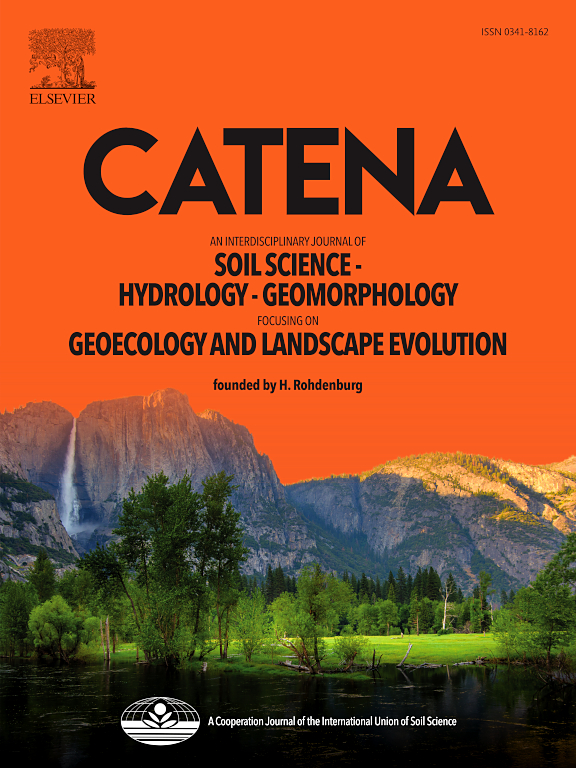Climatic and geological controls on the hydrological response of two neighbouring Eemian palaeolakes (Central Poland): A multi-proxy study
IF 5.4
1区 农林科学
Q1 GEOSCIENCES, MULTIDISCIPLINARY
引用次数: 0
Abstract
This study aims to compare two neighbouring Eemian palaeolakes in central Poland—Kozłów (hydrologically open) and Struga (hydrologically closed)—to improve our understanding of palaeohydrological changes during the last interglacial period (MIS 5e). Using a multi-proxy approach, including pollen and plant macrofossil data, stable carbon and oxygen isotopes, and grain size distributions, we assess the impact of local hydrological conditions on sedimentation and climatic signals. Biogenic sequences record vegetation succession and climatic fluctuations throughout the Eemian, with Kozłów preserving a more continuous archive, whereas Struga exhibits hydrological instability affecting depositional patterns. Pollen data enabled the identification and detailed characterisation of regional pollen assemblage zones (RPAZ), facilitating correlations with regional frameworks across Western and Eastern Europe. Isotopic records at Kozłów indicate evaporative enrichment linked to river inflow and intensified evaporation. In contrast, Struga functioned as a closed basin, with prolonged water residence time and isotope values reflecting internal hydrological balance. Grain size results highlight contrasting sedimentation regimes, with Kozłów showing a transition towards coarser material, suggesting growing fluvial influence, while Struga reveals episodic hydrological fluctuations within a closed-lake system. Climate reconstructions using PPPbase indicate pronounced seasonality and shifts in precipitation patterns during the interglacial. Our findings underscore the contrasting hydrological regimes of Kozłów and Struga, illustrating how local geomorphology and water balance shaped lake evolution. The palaeobotanical record further enhances understanding of catchment dynamics. By integrating isotopic and biological proxies, this study provides a refined reconstruction of Eemian climate evolution and a valuable framework for future interglacial research in Central Europe and beyond.
气候和地质因素对两个相邻埃厄姆古湖(波兰中部)水文响应的控制:多代理研究
本研究旨在比较波兰中部两个相邻的埃米期古湖泊--科兹乌夫湖(水文条件开放)和斯特鲁加湖(水文条件封闭),以加深我们对上一个间冰期(MIS 5e)古水文变化的了解。我们采用多代理方法,包括花粉和植物大化石数据、稳定碳和氧同位素以及粒度分布,评估了当地水文条件对沉积和气候信号的影响。生物成因序列记录了整个埃米期的植被演替和气候波动,其中科兹乌夫保留了更为连续的档案,而斯特鲁加则表现出影响沉积模式的水文不稳定性。花粉数据有助于识别区域花粉组合区(RPAZ)并确定其详细特征,从而便于与整个西欧和东欧的区域框架进行关联。科兹乌夫的同位素记录表明,蒸发富集与河流流入和蒸发加剧有关。相比之下,斯特鲁加是一个封闭的盆地,水体停留时间较长,同位素值反映了内部水文平衡。粒度结果凸显了截然不同的沉积机制,Kozłów 的沉积物向更粗的物质过渡,表明受河流的影响越来越大,而 Struga 则显示了封闭湖泊系统中的偶发性水文波动。使用 PPPbase 进行的气候重建表明,在间冰期降水模式有明显的季节性和变化。我们的研究结果强调了科兹乌夫和斯特鲁加截然不同的水文机制,说明了当地地貌和水量平衡是如何影响湖泊演变的。古植物学记录进一步加深了人们对流域动态的了解。通过整合同位素和生物代用指标,这项研究提供了对埃米纪气候演变的精细重建,并为中欧及其他地区未来的冰期研究提供了一个宝贵的框架。
本文章由计算机程序翻译,如有差异,请以英文原文为准。
求助全文
约1分钟内获得全文
求助全文
来源期刊

Catena
环境科学-地球科学综合
CiteScore
10.50
自引率
9.70%
发文量
816
审稿时长
54 days
期刊介绍:
Catena publishes papers describing original field and laboratory investigations and reviews on geoecology and landscape evolution with emphasis on interdisciplinary aspects of soil science, hydrology and geomorphology. It aims to disseminate new knowledge and foster better understanding of the physical environment, of evolutionary sequences that have resulted in past and current landscapes, and of the natural processes that are likely to determine the fate of our terrestrial environment.
Papers within any one of the above topics are welcome provided they are of sufficiently wide interest and relevance.
 求助内容:
求助内容: 应助结果提醒方式:
应助结果提醒方式:


